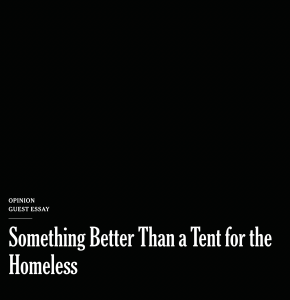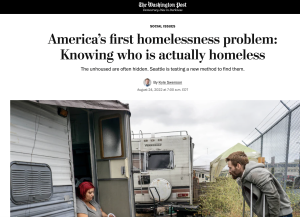Courtney LaCaria
Housing & Homelessness Research Coordinator
Mecklenburg County Community Support Services
Rummaging through old storage boxes, I came across a paper I worked on almost three decades ago, in the fourth grade. The paper was on homelessness, and it was actually the culmination of a whole unit devoted to the topic. I have no conscious recollection of writing it. But I believe that introduction to the topic made an imprint on me, shaping the worldview that I have today.
My fourth grade teacher was organized enough to leave behind clues of what we did: we watched a video about a person named Eddie who had experienced homelessness, to see how difficult life is to survive on the streets; we heard from other speakers about how people who experience homelessness fall outside of our circular economy; we saved grocery receipts to learn firsthand how expensive food is; and we read “The Boxcar Children” to help us learn and develop empathy for peers who experience homelessness. Looking back, I’m blown away. Having been exposed to, and invited to struggle with, these complex issues at that age, how could I not both pay attention to, and want to do something about, them as an adult?
As part of the new monthly series on the state of housing in the community, today’s blog consists of two primary components: a high-level summary of the latest data and trends on housing instability, homelessness, and affordable housing; and a curated list of relevant housing-related news and research from the month prior. Together, these items are intended to keep all stakeholders in the community informed about both the challenges and the solutions related to addressing the problems of housing instability and homelessness.
WHAT HAS CHANGED? THE STATE OF HOUSING, THIS MONTH
This new format provides a high-high-level overview of the trends and latest numbers regarding the demand for affordable housing (which translates to housing instability and homelessness); and the supply of affordable housing in Charlotte-Mecklenburg. More information, including other analysis and data, is provided available by clicking the links below.
The Trends:
- Homelessness continues to increase in Charlotte-Mecklenburg. Since last month, the number of people experiencing homelessness rose by 239. Despite the significant decrease last month, which was primarily due to efforts to clean up data, overall homelessness has been increasing month over month rather than decreasing. It is important to remember that these numbers do not capture the number of people experiencing homelessness under the broader definition, including in doubled up situations or staying in hotels and motels. To read more about the trends, click here.
- Housing instability continues to worsen in Charlotte-Mecklenburg. Although starting to decrease, the number of calls to NC 2-1-1 for housing and shelter assistance was higher than this time last year with 1,824 requests, for rental and mortgage assistance; help in finding low-cost housing; and addressing landlord/tenant issues. To learn more, click here.
- The gap in affordable housing continues to grow in Charlotte-Mecklenburg, especially for households earning the lowest incomes. According to data from the National Low Income Housing Coalition (NLIHC), the Charlotte MSA is facing a shortage of 45,130 units for extremely low-income renters; the situation continues to trend in the wrong direction, as the gap is 3,207 units larger than this time last year.
The Numbers:
Source: One Number (HMIS; updated July 31, 2022) and NC 2-1-1 Counts Service Requests (NC 2-1-1; July 1 – 31, 2022)
READ THIS: A CURATED LIST OF HOUSING-RELATED NEWS, POLICY & RESEARCH
This new feature offers a curated list of news, stories, data and research collected during the previous month that illustrate relevant challenges as well as solutions regarding housing instability, homelessness and affordable housing. All items are accompanied by a summary of what it is and why it matters; and links are provided to learn more information.
Something Better Than a Tent for the Homeless
Last week’s New York Times article by Maia Szalavitz describes how a program called JustCare in Seattle has partnered with downtown businesses to successfully clear encampments and permanently house the individuals who are in them without police enforcement. JustCare relies on outreach workers, many of whom have also experienced homelessness, to partner with encampment residents using a “no-strings attached” approach. After helping residents locate and move into housing, the program cleans up the encampment area. The article reports that between the “fall of 2020 and this past spring JustCare closed 14 encampments and placed over 400 people in hotels and other lodgings. Of the 135 people who had not found permanent homes by March, about two-thirds have now done so, and 21 percent are in various stages of getting the documents and the access to housing they need.”
Senator Warnock Introduces the NLIHC-Supported “Rent Relief Act of 2022” to Establish a Renters’ Tax Credit
The National Low Income Housing Coalition (NLIHC) reported this week about a new bill introduced in both houses that would, like the Child Tax Credit, use a tax credit to provide financial assistance for low-income renters. The goal of the tax credit is to literally cover (and close) the gap between what low-income renters can afford and the cost of their housing.
America’s first homelessness problem: Knowing who is actually homeless
This Washington Post article by Kyle Swenson spotlights a new counting method, employing surveys. It is an attempt by King County to address the overall “flawed methodology” of the annual Point-in-Time Count (a required activity of Continuums of Care, like Charlotte-Mecklenburg), as well as the implications of poor estimates. According to the article, the new method in Seattle, which was used during the 2022 Point-in-Time Count, resulted in 1,617 more individuals being counted as experiencing homelessness on a single night than compared with the previous count completed in 2020.
SO, WHAT
I’m grateful to my teacher for simply having showed us the problem of homelessness. Beyond that, she also helped us to think critically about why it even exists in the first place. She also forced us to consider what homelessness might look and feel like. I’ve learned a lot about homelessness since that unit in the fourth grade. I’ve also learned a lot about myself, and what truly matters.
My first job out of graduate school was working with a local non-profit which helped families experiencing homelessness. Green and naïve, I thought if my client only followed the steps, they’d make it out and into a permanent home, for good. Mapping out a budget would fix everything. I learned that it doesn’t work that way. Moreover, making the family change was rarely the right solution. The systems and structures that contributed to their homelessness in the first place were the real problems to be solved.
As an adult, I have experienced both homelessness and unemployment. I have seen firsthand what systems and structures make people do to regain something that they have lost. I have witnessed the indignity of moral imperatives that require a person to prove their worthiness, rather than address the actual problem. I have experienced the judgment that comes from family and friends.
Personal responsibility is a thing. So is collective responsibility. Why should any of us care about addressing housing instability and homelessness? Do you have to actually experience homelessness to know how horrible it is and want to do something about it? No. There are plenty of individuals, both staff and volunteers, who spend countless hours devoted to addressing homelessness because they believe it is the right thing to do.
Do you have to believe it is the right thing to do to make a difference? No, again. There are plenty of other reasons to end housing instability and homelessness: cleaner sidewalks; stronger economies; improved health and educational outcomes.
If we know that it is good for us to end homelessness, and we have the tools and the means to do so, then why can’t we do it?
Antoine de Saint-Exupery said, “If you want to build a ship, don’t drum up people to collect wood and don’t assign them tasks and work, but rather teach them to long for the endless immensity of the sea.”
I am beyond fortunate that I had a teacher who showed me a different version of the world; and cultivated at an early age a longing for a community that offers housing for all.
SIGN UP FOR BUILDING BRIDGES BLOG
Courtney LaCaria coordinates posts on the Building Bridges Blog. Courtney is the Housing & Homelessness Research Coordinator for Mecklenburg County Community Support Services. Courtney’s job is to connect data on housing instability, homelessness and affordable housing with stakeholders in the community so that they can use it to drive policy-making, funding allocation and programmatic change.





